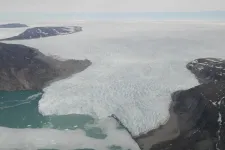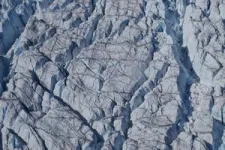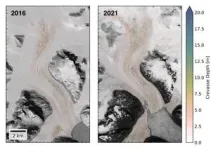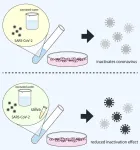(Press-News.org) Embargoed until 10am GMT UK time (5am US Eastern Time) on Monday 03 February 2025 (Nature Geoscience embargo)
-With pictures-
The Greenland Ice Sheet is cracking open more rapidly as it responds to climate change.
The warning comes in a new large-scale study of crevasses on the world’s second largest body of ice.
Using 3-D surface maps, scientists led by Durham University, UK, found crevasses had significantly increased in size and depth at the fast-flowing edges of the ice sheet over the five years between 2016 and 2021.
This means the increases in crevasses are happening more quickly than previously detected. Crevasses are wedge-shaped fractures or cracks that open in glaciers where ice begins to flow faster. The researchers say that crevasses are also getting bigger and deeper where ice is flowing more quickly due to climate change, and that this could further speed up the mechanisms behind the loss of ice from Greenland.
They hope their findings will allow scientists to build the effects of ice damage and crevassing into predictions of the future behaviour of the Greenland Ice Sheet.
The research is published in the journal Nature Geoscience.
Greenland has been behind approximately 14mm of sea level rise since 1992. This is due to increased melting from the ice surface in response to warmer air temperatures, and increased flow of ice into the ocean in response to warmer ocean temperatures, which are both being driven by climate change.
Greenland contains enough ice to add seven metres (23 feet) of sea level rise to the world’s oceans if the entire ice sheet were to melt. Research has shown that Greenland could contribute up to 30cm (one foot) to sea level rise by 2100.
For this latest study, the Durham-led researchers used more than 8,000 3-D surface maps, created from high-resolution satellite imagery, to identify cracks in the surface of the ice sheet and show how crevasses had evolved across Greenland between 2016 and 2021.
The research found that, at the edges of the ice sheet where large glaciers meet the sea, accelerations in glacier flow speed were associated with significant increases in the volume of crevasses. This was up to 25 per cent in some sectors (with an error margin of plus/minus ten per cent).
These increases were offset by a reduction in crevasses at Sermeq Kujalleq, the fastest-flowing glacier in Greenland, which underwent a temporary slowdown in movement during the study period.
This balanced the total change in crevasses across the entire ice sheet during the study period to plus 4.3 per cent (with an error margin of plus/minus 5.9 per cent). However, Sermeq Kujalleq’s flow speed has since begun increasing again – suggesting that the period of balance between crevasse growth and closure on the ice sheet is now over.
Study lead author Dr Tom Chudley, a Leverhulme Early Career Fellow in the Department of Geography, Durham University, UK, said: “In a warming world, we would expect to see more crevasses forming. This is because glaciers are accelerating in response to warmer ocean temperatures, and because meltwater filling crevasses can force fractures deeper into the ice. However, until now we haven’t had the data to show where and how fast this is happening across the entirety of the Greenland Ice Sheet.
“For the first time, we are able to see significant increases in the size and depth of crevasses at fast-flowing glaciers at the edges of the Greenland Ice Sheet, on timescales of five years and less.
“With this dataset we can see that it’s not just that crevasse fields are extending into the ice sheet, as previously observed – instead, change is dominated by existing crevasse fields getting larger and deeper.”
Increased crevassing has the potential to speed up the loss of ice from Greenland.
Study co-author Professor Ian Howat, Director of the Byrd Polar & Climate Research Center at The Ohio State University, USA, said: “As crevasses grow, they feed the mechanisms that make the ice sheet’s glaciers move faster, driving water and heat to the interior of the ice sheet and accelerating the calving of icebergs into the ocean.
“These processes can in turn speed up ice flow and lead to the formation of more and deeper crevasses - a domino effect that could drive the loss of ice from Greenland at a faster pace.”
The research used imagery from the ArcticDEM project, a National Geospatial-Intelligence Agency (NGA) and National Science Foundation (NSF) public-private initiative to automatically produce a high-resolution, high-quality digital surface model of the Arctic. ArcticDEM imagery was provided by the Polar Geospatial Center.
Professor Howat added: “The ArcticDEM project will continue to provide high-resolution Digital Elevation Models until at least 2032. This will allow us to monitor glaciers in Greenland and across the wider Arctic as they continue to respond to climate change in regions experiencing faster rates of warming than anywhere else on Earth.”
The research team also included Dr Michalea King from the University of Washington and Dr Emma MacKie at the University of Florida, both USA.
The study was funded by a Leverhulme Trust Early Career Fellowship, NASA, and the National Science Foundation Office for Polar Programs.
ENDS
END
Cracks in Greenland Ice Sheet grow more rapidly in response to climate change
2025-02-03
ELSE PRESS RELEASES FROM THIS DATE:
Computer model helps identify cancer-fighting immune cells key to immunotherapy
2025-02-03
*EMBARGOED FOR RELEASE UNTIL MONDAY, FEB. 3, AT 5 A.M. ET*
Researchers at the Johns Hopkins Kimmel Cancer Center and Bloomberg~Kimmel Institute for Cancer Immunotherapy have developed a computer model to help scientists identify tumor-fighting immune cells in patients with lung cancer treated with immune checkpoint inhibitors.
In their study published Feb. 3 in Nature Communications, the team, including first author Zhen Zeng, Ph.D., a bioinformatics research associate at the Kimmel Cancer Center, demonstrated that their three-gene “MANAscore” computer model can identify ...
Keeper or corner?
2025-02-03
Our brain is remarkably flexible in producing different reactions to supposedly comparable situations. The same sensory information can lead to different decisions depending on the behavioral context. One example of this is a penalty kick in soccer: a player can either choose the empty corner of the goal as the target or aim directly at the goalkeeper in the hope that he will jump aside. Both decisions are based on the same perception of the goalkeeper's position, but lead to completely different actions. Neuroscientists at the German Primate Center (DPZ) - Leibniz Institute for Primate Research in Göttingen have investigated how the brain implements this ...
Printable molecule-selective nanoparticles enable mass production of wearable biosensors
2025-02-03
The future of medicine may very well lie in the personalization of health care—knowing exactly what an individual needs and then delivering just the right mix of nutrients, metabolites, and medications, if necessary, to stabilize and improve their condition. To make this possible, physicians first need a way to continuously measure and monitor certain biomarkers of health.
To that end, a team of Caltech engineers has developed a technique for inkjet printing arrays of special nanoparticles that enables the mass production of long-lasting wearable sweat sensors. These sensors could be used to monitor a variety of biomarkers, ...
Mapping the yerba mate genome reveals surprising facts about the evolution of caffeine
2025-02-03
Yerba mate, along with tea and coffee, is one of the world’s most popular caffeinated beverages. Widely consumed in South America, this remarkable plant is rich in diverse, bioactive compounds that contribute many health benefits.
An international group of researchers has mapped the yerba mate genome, providing insights into the biosynthesis of caffeine in yerba mate. This new information provides opportunities for creating plant varieties with new characteristics.
The work, led by the ...
Electricity prices across Europe to stabilise if 2030 targets for renewable energy are met, study suggests
2025-02-03
Hitting the current national 2030 quotas for solar and wind energy could reduce the volatility of electricity markets by an average of 20% across 29 European countries, according to a new study from the University of Cambridge.
The intensity of spikes in power prices are predicted to fall in every country by the end of the decade if commitments to green energy are met, as natural gas dependency is cut.
The UK and Ireland would be the biggest beneficiaries, with 44% and 43% reductions in the severity of electricity price spikes by 2030, compared with last year.
Germany could experience a 31% decline in electricity price ...
Improved treatment timing reduces honey bee losses to Varroa mites
2025-02-03
Honey bee mortality can be significantly reduced by ensuring that treatments for the parasitic Varroa mite occur within specific timeframes, a new study reveals.
The mites—belonging to the species Varroa destructor—feed on the larvae of bees and can destroy colonies if not treated at key points to reduce or remove infestations.
But researchers have found that more than a third of beekeepers surveyed in England and Wales deviate from recommended treatment guidelines, including application windows.
Crucially, they found that beekeepers who mistimed Varroa mite treatments experienced exacerbated colony losses, with the effect occurring ...
CAR-T cells can arm bystander T cells with CAR molecules via trogocytosis
2025-02-03
Engineered immune cells called CAR-T cells are used in the treatment of cancer. Researchers from Uppsala University have now discovered that CAR molecules can be transferred from the CAR-T cells to other T cells in the tumour microenvironment. The researchers also pinpoint how this transfer is regulated, which may be used to improve the efficacy of CAR-T cell therapy. The study has been published in the journal Science Immunology.
Immune cells have a capacity to exchange cell surface molecules between one another. This exchange is called trogocytosis and may potentially impact the immune response since it allows different proteins to be transferred between cells.
Chimeric antigen ...
Can ocean-floor mining oversights help us regulate space debris and mining on the Moon?
2025-02-03
by Nishith Mishra, Martina Elia Vitoloni, and Dr Joseph Pelton
Mining ocean resources needed for electric cars and other devices is currently a hot issue of dispute. Final resolution of how or whether the seabed should be expl18oited is pending. Outcomes in this contentious area could create precedents that could impact decisions about mining the moon.
These precedents might shape the how and why of mining the Moon and shape the future and the sustainability of space activities of human beings. But this is only one possible precedent that could reshape the future of space.
Pending international discussions on space traffic management, space debris removal, and limiting ...
Observing ozonated water’s effectiveness against SARS-CoV-2 in saliva
2025-02-03
Disinfecting surfaces is crucial in keeping bacteria and viruses at bay, but the cleaning solutions could be ineffective if met with neutralizing compounds.
Ozonated water has a strong disinfection effect on mold and bacteria, and is also shown to work on SARS-CoV-2, which is responsible for COVID-19. The downside is that ozonated water breaks down quickly in the presence of organic matter, which reduces its effectiveness. SARS-CoV-2 is transmitted through droplets mixed with bodily fluids, such as saliva and nasal mucus which contain organic matters. For this reason, it is necessary to investigate how effective ozonated water is in the presence of ...
Alcohol-related deaths up 18% during pandemic
2025-02-03
Alcohol-related deaths increased 18% during the pandemic, as did hospitalizations related to alcohol use, according to new research in CMAJ (Canadian Medical Association Journal) https://www.cmaj.ca/lookup/doi/10.1503/cmaj.241146.
In the early part of the pandemic, retail alcohol sales volume in Canada increased by 2% (2020/21 v. 2019), the highest increase in 10 years, despite few international visitors. More than 1 in 4 people (26%) reported drinking more, and 18% reported heavy drinking (defined as ...







